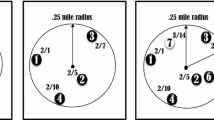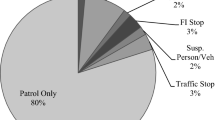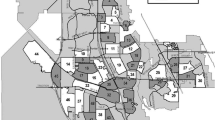Abstract
Objectives
To evaluate with an ex post facto quasi-experimental design the impact of tactical police response on residential theft from vehicle crime in micro-time hot spots as well as whether spatial displacement occurs.
Methods
The evaluation uses 5 years of data from one police agency that responded to micro-time hot spots as part of its normal crime reduction efforts. To determine the experimental comparison group, propensity scores were computed using logistic regression. Cases were matched using greedy 1–1 matching with a caliper of 0.10 of the standard deviation of the logit of the propensity score and resulted in 86 pairs. t Tests were used to examine the effect of the treatment and whether spatial displacement of crime occurred as a result.
Results
Results showed that when police responded with about seven responses per day and for between 2 and 3 weeks, there was nearly a 20 % reduction in residential theft from vehicle crimes, and the micro-time hot spots with response did not last as long as those that did not. Results also showed no spatial displacement of crime as a result of the response.
Conclusions
This evaluation is first to examine tactical police strategies for property crimes occurring at micro-places in micro-time. Findings support the hypothesis that micro-time hot spots are less severe and “cool off” more quickly after a response. Thus, police should consider responding to property crime occurring in micro-places at a smaller temporal unit. Future research should further explore this unit of police response to corroborate these results.

Similar content being viewed by others
Notes
The agency employs the Stratified Model of Problem Solving, Analysis, and Accountability (i.e., “Stratified Model”) as its organizational framework for systemizing evidence-based crime reduction strategies into the police organization’s day-to-day practices by providing actionable crime analysis products and a foundation for problem solving accountability through a structured set of meetings (Boba and Santos 2011). The Port St. Lucie, FL Police Department’s institutionalization of the Stratified Model has been successful as evidenced by a process and impact evaluation (Santos 2013a; Santos and Santos 2012), and this work has received one of the most prestigious awards in policing, the International Association of Chiefs of Police Law Enforcement Research Award (IACP 2010).
This was based on the recommendations made by Thoemmes and Kim (2011) in their meta analysis of 86 social science research articles using propensity score matching to assign experimental groups.
Cochran and Rubin (1973) found that using caliper widths of below 0.20 of the standard deviation of the logit eliminated approximately 99 % of the bias when estimating linear treatment effects. Austin (2010) confirmed this finding and recommended 0.20 of the standard deviation of the logit or lower as the optimal caliper width.
As recommended by Imai et al. (2008).
For a detailed discussion of Rossenbaum Bounds and its use in STATA, see Becker and Caliendo (2007).
Based on these findings, we are currently implementing a random controlled trial to test the effectiveness of police response in micro-time hot spots. Like this evaluation, it examines tactical police response to property crime micro-time hot spots as part of a police organization’s “normal” operational practices, but instead of an ex post facto evaluation, the micro-time hot spots are randomly assigned to treatment and control groups. To improve on this evaluation, we have tightened the criteria for a micro-time hot spot, are doing block randomization by two groups, and are collecting much more detailed response data. We are 18 months into a 24–30 month treatment period.
References
Austin PC (2008) The performance of different propensity-score methods for estimating relative risks. J Clin Epidemiol 61:537–545
Austin PC (2010) Optimal caliper widths for propensity-score matching when estimating differences in means and differences in proportions in observational studies. Pharm Stat 10:150–161
Austin R, Cooper G, Gagnon D, Hodges J, Martensen K, O’Neal M (1973) Police crime analysis unit hand-book. National Institute of Law Enforcement and Criminal Justice, Washington, DC
Bales WD, Piquero AR (2012) Assessing the impact of imprisonment on recidivism. J Exp Criminol 8:71–101
Barr R, Pease K (1990) Crime placement, displacement, and deflection. Crime Justice 12:277–318
Becker SO, Caliendo M (2007) Sensitivity analysis for average treatment effects. Stata J 7:71–83
Bernasco W (2008) Them again? Same-offender involvement in repeat and near repeat burglaries. Eur J Criminol 5:411–431
Bernasco W (2010) A sentimental journey to crime: effects of residential history on crime location choice. Criminology 48:389–416
Bernasco W, Nieuwbeerta P (2005) How do residential burglars select target areas? A new approach to the analysis of criminal location choice. Br J Criminol 44:296–315
Boba R, Santos RG (2011) A police organizational model for crime reduction: Institutionalizing problem solving, analysis, and accountability. Office of Community Oriented Policing Services, Washington, DC
Bowers KJ, Johnson SD (2005) Domestic burglary repeats and space–time clusters: the dimensions of risk. Eur J Criminol 2:67–92
Braga AA, Weisburd DL (2012) The effects of focused deterrence strategies on crime: a systematic review and meta-analysis of the empirical evidence. J Res Crime Delinq 49:323–358
Braga AA, Hureau D, Papachristos A (2012) An ex-post-facto evaluation framework for place-based police interventions. Eval Rev 35:592–626
Braga AA, Papachristos AV, Hureau DM (2014) The effects of hot spots policing on crime: an updated systematic review and meta-analysis. Justice Q 31:633–663
Caeti T (1999) Houston’s targeted beat program: a quasi-experimental test of police patrol strategies. Doctoral Dissertation Sam Houston State University, TX
Cochran WG, Rubin DB (1973) Controlling bias in observational studies: a review. Sankhya Ser A 35:417–446
Farrell G, Pease K (1993) Once bitten, twice bitten: repeat victimization and its implications for crime prevention. Home Office, London
Guerette RT, Bowers KJ (2009) Assessing the extent of crime displacement and diffusion of benefits: a review of situational crime prevention evaluations. Criminology 47:1331–1368
Gwinn S, Bruce C, Cooper J, Hick S (2008) Exploring crime analysis: readings on essential skills. BookSurge, Charleston
Hesseling RB (1994) Displacement: A review of the empirical literature. In: Clarke RV (ed) Crime prevention studies. Criminal Justice Press, Monsey, pp 197–270
Ho DE, Imai K, King G, Stuart EA (2007) Matching as nonparametric preprocessing for reducing model dependence in parametric causal inference. Polit Anal 15:199–236
Imai K, King G, Stuart E (2008) Misunderstandings among experimentalists and observationalists about causal inference. J R Stat Soc A Stat 171:481–502
International Association of Chiefs of Police (2010) IACP/Sprint Excellence in Law Enforcement Research Award Program: Spotlighting the power & impact of law enforcement academic research partnerships. Author, Alexandria
Johnson SD, Bowers KJ (2004) The burglary as a clue to the future: the beginnings of prospective hot-spotting. Eur J Criminol 1:237–255
Johnson SD, Summers L, Pease K (2007) Vehicle crime: communicating spatial and temporal patterns. Jill Dando Institute of Crime Science, London
Johnson SD, Summers L, Pease K (2009) Offenders as forager: a direct test of the boost account of victimization. J Quant Criminol 25:181–200
Keele L (2010). An overview of rbounds: an R package for Rosenbaum bounds sensitivity analysis with matched data. Retrieved October 2014. www.personal.psu.edu/ljk20/rbounds%20vignette.pdf
Keister T (2007) Thefts of and from cars on residential streets and driveways. Office of Community Oriented Policing Services, Washington, DC
McLaughlin L, Johnson SD, Bowers KJ, Birks DJ, Pease K (2007) Police perceptions of the long-and short-term spatial distribution of residential burglary. Int J Police Sci Manag 9:99–111
Papachristos A, Meares T, Fagan J (2007) Attention felons: evaluating project safe neighborhoods in Chicago. J Empir Legal Stud 4:223–272
Police Executive Research Forum (2008) Violent crime in America: what we know about hot spots enforcement. Critical issues in policing series. Author, Washington, DC
Ratcliffe JH, Taniguchi T, Groff ER, Wood JD (2011) The Philadelphia foot patrol experiment: a randomized controlled trial of police patrol effectiveness in violent crime hotspots. Criminology 49:795–831
Reppetto T (1976) Crime prevention and the displacement phenomenon. Crime Delinq 22:166–177
Rosenbaum PR (2002) Observational studies. Springer, New York
Rosenbaum DP (2006) The limits of hot spots policing. In: Weisburd D, Braga AA (eds) Police innovation: contrasting perspectives. Cambridge University Press, New York, pp 245–266
Rosenbaum PR, Rubin DB (1985) The bias due to incomplete matching. Biometrics 41:103–116
Rubin DB (2006) Matched sampling for causal effects. Cambridge University Press, New York
Sagovsky A, Johnson SD (2007) When does repeat burglary victimization occur? Austl N Z J Criminol 40:1–26
Santos RB (2012) Crime analysis with crime mapping. Sage, Thousand Oaks
Santos RB (2013a) Implementation of a police organizational model for crime reduction. Policing 32:295–311
Santos RG (2013b) A quasi-experimental test and examination of police effectiveness in residential burglary and theft from vehicle micro-time hot spots. Dissertation. Nova Southeastern University
Santos RB, Santos RG (2012) The role of leadership in implementing a police organizational model for crime reduction and accountability. Polic J Policy Pract 6:344–353
Santos RB, Taylor B (2014) The integration of crime analysis into police patrol work: results from a national survey of law enforcement. Policing 37:501–520
Schafer JL, Kang J (2008) Average causal effects from nonrandomized studies: a practical guide and simulated example. Psychol Methods 13:279–313
Science M, Johnstone J, Roth DE, Guyatt G, Loeb M (2012) Zinc for the treatment of the common cold: a systematic review and meta-analysis of randomized controlled trials. Can Med J 184:551–561
Sherman LW, Rogan DP (1995) Effects of gun seizures on gun violence: ‘Hot spots’ patrol in Kansas City. Justice Q 12:673–694
Stuart E (2008) Developing practical recommendations for the use of propensity scores: discussion of ‘A critical appraisal of propensity score matching in the medical literature between 1996 and 2003’ by Peter Austin. Stat Med 27:2062–2065
Taylor B, Koper C, Woods D (2011) A randomized controlled trial of different policing strategies at hot spots of violent crime. J Exp Criminol 7:149–181
Telep CW, Weisburd D (2012) What is known about the effectiveness police practices in reducing crime and disorder? Police Q 15:331–357
Telep CW, Mitchell RJ, Weisburd D (2014) How much time should the police spend at crime hot spots? Answers from a police agency directed randomized field trial in Sacramento, California. Justice Q 31:905–933
Thoemmes F (2012) Propensity score matching in SPSS. arXiv preprint arXiv:1201.6385
Thoemmes F, Kim ES (2011) A systematic review of propensity score methods in the social sciences. Multivar Behav Res 46:90–118
Townsley M, Homel R, Chaseling J (2003) Infectious burglaries: a test of the near repeat hypothesis. Br J Criminol 43:615–633
Weisburd D, Lum C (2005) The diffusion of computerizes crime mapping in policing: linking research and practice. Police Pract Res 6:419–456
Weisburd DL, Telep CW (2014) Hot spots policing: what we know and what we need to know. J Contemp Crim Justice 30:200–220
Weisburd D, Telep C, Braga A (2010a) The importance of place in policing: Empirical evidence and policy recommendations. Swedish National Council for Crime Prevention, Information, and Publications, Stockholm, Sweden
Weisburd D, Telep C, Hinkle J, Eck J (2010b) is problem-oriented policing effective in reducing crime and disorder? Findings from a Campbell systematic review. Criminol Public Policy 9:139–172
Weisburd D, Groff ER, Yang S-M (2012) The criminology of place: street segments and our understanding of the crime problem. Oxford University Press, New York
Author information
Authors and Affiliations
Corresponding author
Rights and permissions
About this article
Cite this article
Santos, R.G., Santos, R.B. An Ex Post Facto Evaluation of Tactical Police Response in Residential Theft from Vehicle Micro-time Hot Spots. J Quant Criminol 31, 679–698 (2015). https://doi.org/10.1007/s10940-015-9248-7
Published:
Issue Date:
DOI: https://doi.org/10.1007/s10940-015-9248-7




